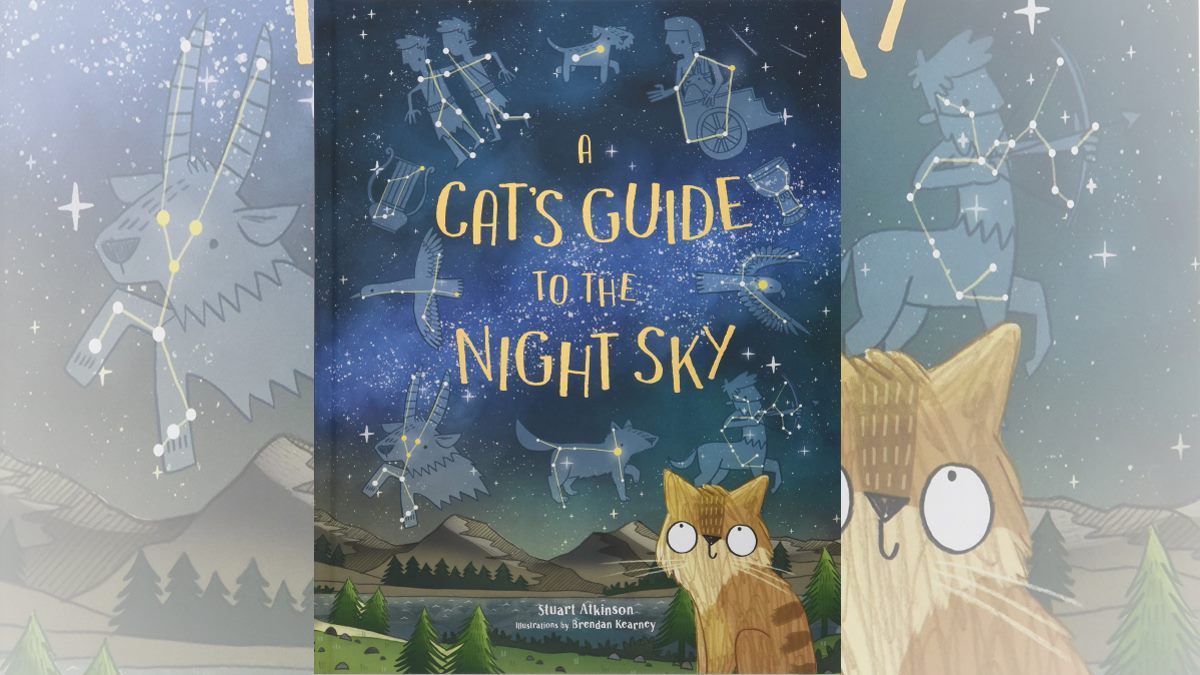 This Week’s Word Is “Asterism.”
This Week’s Word Is “Asterism.”
There’s something great about a book that’s aimed at young children that can still teach adults something. Even adults that have an interest in the subject matter. Reading A Cat’s Guide to the Night Sky, I learned the term “asterism,” which is a pattern or group of stars within a constellation (AKA the bright bits!). I had no idea this has a specific term. And now I do.
Which is why I chose asterism to be my word of the week. This has nothing to do with the fact I already used “astronomy,” last year.
What is A Cat’s Guide to the Night Sky?
A slimline hardback astronomy book for younger children (around 7 upwards.), published by Laurence King. It’s a guide to stargazing for youngsters, led by Felicity, a cat who loves to watch the stars. The book covers the practicalities of staring at the night sky: Finding somewhere away from the glare of streetlights, wrapping up warm, (and taking chocolate with you), and rudimentary positional astronomy, as well as a discussion of the various types of star and other celestial objects.
There are no photographs in the book. Everything is rendered in a slightly naive colored drawing style, that is well chosen considering the intended audience.
The book focuses almost entirely on the northern hemisphere. The book’s rudimentary star charts, that show what is visible during a given season, show only what can be seen from the north half of the globe.
Why Read A Cat’s Guide to the Night Sky?
If you live in the southern hemisphere, don’t. In the page detailing the Pole Star, there is no mention of the Southern Cross or that below the equator the Pole Star would be impossible to see. There isn’t really any mention that what you can see in the southern hemisphere is different from that in the north. This is quite a big failing in the book, I think.
I can appreciate that in a children’s book you may not want to confuse matters be showing several pages devoted to constellations they can’t ever see, but I feel that some note of the difference should be made somewhere.
Hemispherical bias aside, A Cat’s Guide to the Night Sky is an excellent child-friendly introduction to astronomy. Its slightly cutesy aesthetic belies the depth of information covered. The book is very visually appealing and it uses this hook to deliver information on a wide range of topics.
The are four beautifully illustrated diagrams that breakdown what you might see in each season. This gives young readers something they can immediately relate to as they try to grasp the secrets of the skies above them. Beyond the book’s positional astronomy, there is an excellent page devoted to star types and an explanation of their differing colors. You won’t see the word’s “Hertzprung Russell diagram” anywhere, but the book depicts its main sequence in a fashion that will fire up inquisitive minds.
Similarly, pages on the moon, eclipses, and the solar system deliver their science in an accessible manner. There are explanations of the phases of the moon, how it was formed, the best ways to view each of the planets and how to tell if what you are looking at is a planet or a star. There’s no hard planet data here, but the book will serve as a jumping off point for further exploration.
I do wish the book was a little more overt with its instructions not to look at the sun. I can still remember the bold bannered warnings on my astronomy books as a child, and I most definitely heeded them. There is a small warning here in the eclipse section, but considering the section about stars and the sun opens with, “… the best way to see a star is on a sunny day,” I think a stronger warning is was needed at that point. (The actual warning doesn’t appear for another 30 pages.)
For readers in the northern hemisphere, A Cat’s Guide to the Night Sky is a great way to inspire your children to look at the stars. All too often we spend ourselves shut inside, huddled round separate devices tuning in to whatever digital entertainment is currently floating our boat. Books that provide practical tips, along with inspiration to get outside should be applauded. I loved looking at the night sky when I was young, and this book has reminded me why. It’s made me a little sad that I don’t do it very often with my own children. Hopefully, I can use A Cat’s Guide to the Night Sky to inspire them to come and stand outside with me under the chill winter skies.
If you’d like to pick up a copy of A Cat’s Guide to the Night Sky, you can do so, here.
If you enjoyed this review, do check out my other Word Wednesday reviews, here.
Disclosure: I received a copy of this book in order to write this review.




